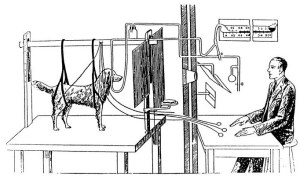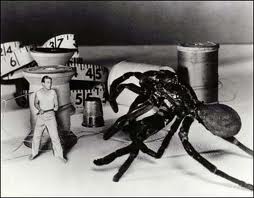Pavlov loved the liberal, academic atmosphere at Sussex, and spent many hours in what then was euphemistically called ‘East Slope Bar’ (because of its ability to slope eastwards and be a bar at the same time). He had decided that his next goal was to prove that associative conditioning was a basic and universal learning process, and that it was the most basic adaptive learning mechanism in the animal kingdom. There was no doubt that classical conditioning was universal – it could be found in primates right down to single celled organisms (yes, even nematodes), but for Pavlov there was something missing. His conditioning theory was incomplete. It had to apply to animals of all kinds, creeds, political persuasion, and psychic state.
To this end, Pavlov dedicated his sabbatical year at the University of Sussex to determining whether classical conditioning applied to dead as well as living organisms. This was a stroke of genius. Only very few scientists possess the insight that allows them to project their theories into areas which are challenging and paradigm shifting (e.g. Sheldrake[2], Bem[3]), but Pavlov was such a scientist.
Pavlov began his research by looking for a source of dead dogs that would serve as subjects in his research. He very soon found that source at the ‘Goods Inwards’ door of the University Refectory. He negotiated a regular supply of dead dogs for his experiments, and the University Hospitality services have recently recognized the historical importance of this by erecting a brass plaque outside the University cafeteria commemorating their role in Pavlov’s sabbatical research.

“ I placed the subject on the experimental table; I rang the bell; I waited very briefly then I gave the dog the food….. Nothing.! ….No salivation! - I was puzzled. This had always worked before in the lab in St. Petersburg. Why was this so different in the University of Sussex? I could not believe that my universal learning principles did not also apply to dead organisms. But wait….of course! This was only the first trial. There will be no learning on the first trial! We must pair the bell with food on more occasions.”
Pavlov’s scientific logic was impeccable. He continued with his experimental procedure, but time eventually told a sad story. Although Pavlov had strived manfully to extend his so-called universal principles of learning to dead animals, it didn’t appear to work. His dead dogs failed to salivate to the bell CS even after hundreds of conditioning trials. Nevertheless, being the scientist that he was, and after many hours and days of detailed thought and analysis, Pavlov came to the obvious conclusion. It was not that dead dogs were not conditionable - they were in fact deaf. Pavlov had managed to salvage his universal principle of learning by taking a thoughtful and insightful new look at the data. Any of you that have come across a dead dog will be fully aware that deafness is indeed a feature of dead dogs, and our knowledge of this feature stems from Pavlov’s pioneering experimental work during his sabbatical year at the University of Sussex.
[1] De Bono E (1976) The Greatest Thinkers. Weidenfeld & Nicolson: London
[2] Sheldrake R (2012) The Science Delusion. Coronet.
[3] Bem D. J. (2011) Feeling the future: Experimental evidence for anomalous retroactive influences on cognition and affect. Journal of Personality & Social psychology, 100, 407-425.






 RSS Feed
RSS Feed